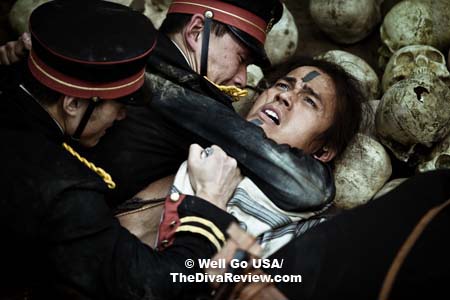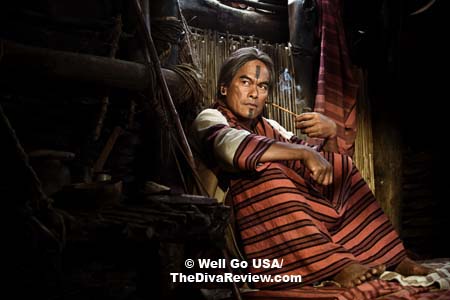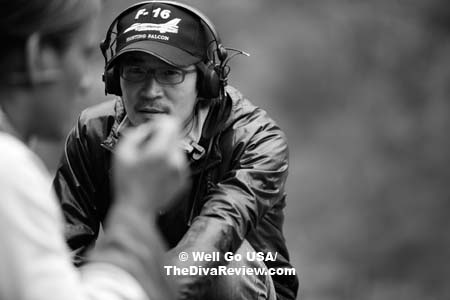
Hey all, so happy to have an exclusive talk with the men behind Warriors of the Rainbow: Seediq Bale, the action film based on the real life do-or-die battle that the indigenous tribes of Taiwan waged against Japanese oppressors. Director Wei Te-sheng and lead actor Lin Ching-tai discuss how the story is important for promoting racial and spiritual understanding and why in this film, there are no bad guys.
Dig it!
Warriors of the Rainbow: Seediq Bale
Director Wei Te-sheng and Actor Lin Ching-tai
 The
Lady Miz Diva: Director Wei, how did this story of the Seediq Bale
people come to you?
The
Lady Miz Diva: Director Wei, how did this story of the Seediq Bale
people come to you?
Wei Te-sheng: When I was little, I read about the incident in the textbooks, but it was only two lines, I didnít pay attention to it. A couple of years later, I found a book in a bookstore that described the whole incident and it shocked me as to how much history there was compared to the texts that I read when I was young. So, that had a lot of impact and I started to do further research and I found it fascinating. What prompted me to do the movie was that I realised there were a lot of stories like this; with people trying to repel an outside force to take over our lands. The difference with this movie is I was looking to talk about a spiritual freedom, rather than the freedom itself. The warriors know they are fighting a battle they cannot win, but they fight it anyway. Itís fascinating, trying to find what theyíre looking for in terms of spirit and the fight itself.
LMD: What made you decide that Mr. Lin was your leading man?
Wei: When I first met Lin Ching-tai, it was about his presence and his characteristics that told me he was the guy that I wanted. There were a lot of physical characteristics that I thought fit for the leading character, as well. I discovered that Lin had a lot to relate to the character when he was young.
 LMD:
Mr. Lin, can you talk about how you prepared to play the tribal leader,
Mouna Rudo? Were you aware of the real life incidient?
LMD:
Mr. Lin, can you talk about how you prepared to play the tribal leader,
Mouna Rudo? Were you aware of the real life incidient?
Lin Ching-Tai: I didnít know I was playing the lead character in the first place. I didnít know anything about filmmaking. Eventually, when I got the role, I had a lot of dialogue and I had a dialogue coach to coach me about the aboriginal language and that was a big help.
I knew about the story when I was a child, but not very much.
LMD: What were some of the challenges in editing the two-part film down to a single feature?
Wei: It was very difficult to know where to cut. I didnít want to cut anything because of the time issue. It was like my baby and it was a hard time to let go. I thought about what I wanted to do in terms of delivering a message to audiences overseas, and it became clear for me that I wanted let them to know the brutality of war and the history of the aboriginal people. So, I focused on the war and brutality itself, rather than exposition and thatís what I focused on in the two-hour version.
 LMD:
Did you have any hesitation about the filmís representation of the
Japanese possibly antagonizing Japanese viewers?
LMD:
Did you have any hesitation about the filmís representation of the
Japanese possibly antagonizing Japanese viewers?
Wei: I didnít think of the Japanese as being right or wrong, or however we should view them, because I think history is written by the winners and the Japanese werenít necessarily good or bad in terms of how people view them. I just wanted to take the matter into my own hands and tell the story the way it was. So, I think the reason I made the film was because I think the Japanese people have their own belief and the indigenous people have their own belief, and one believed in the Empire of the Sun and one believed in the Bridge of the Rainbow, and theyíre just fighting for their beliefs. When you put too much judgment into who is right or who is wrong, incidents have happened. I was focusing more on the incident itself and not making so much of a judgment.
LMD: Could you clarify why the Seediq Bale women killed themselves in that very dramatic scene?
Wei: The indigenous people knew they were fighting a battle they were definitely going to lose. The women didnít want their warriors to have to worry about them and the children and focus on the battlefield, because they were going to die anyway, so they would just commit suicide rather than having their lives taken by the Japanese.
 LMD:
What was the greatest challenge of filming in those beautiful,
mountainous locations?
LMD:
What was the greatest challenge of filming in those beautiful,
mountainous locations?
Wei: The biggest challenge was the terrain of the location. We had a lot of locations that required a lot of equipment to be brought there, but we would find it impossible to set up, and so we took a lot of time dealing with that. And the weather could be unpredictable, as well; we had a lot of rain and sun. Weíd never get the desirable state that we wanted to shoot, so we had to deal with the variables with the weather. The actors had a lot of trouble running around and taking care of them and having them not getting hurt. It was very challenging.
 LMD:
What would each of you like for audiences to take away from Warriors of
the Rainbow?
LMD:
What would each of you like for audiences to take away from Warriors of
the Rainbow?
Lin: I want the audience to take away the stories of the indigenous people of Taiwan and their way of life and their spirituality. So, introducing them to this kind of life is the biggest hope I have.
 Wei:
I think that the Seediq tribe story isnít just a specific case in
Taiwan; it also represents that there are many, many racial conflicts in
the world. Hopefully, it will remind people to relate to the conflicts
and think about how we can live in peace and if we could at all learn
from this experience.
Wei:
I think that the Seediq tribe story isnít just a specific case in
Taiwan; it also represents that there are many, many racial conflicts in
the world. Hopefully, it will remind people to relate to the conflicts
and think about how we can live in peace and if we could at all learn
from this experience.
~ The Lady Miz Diva
Apr 24th, 2012
© 2006-2022 The Diva Review.com
|
|































